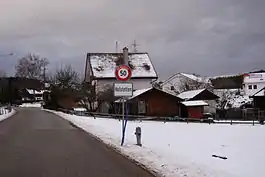Hofstetten, Zürich
Hofstetten is a former municipality in the district of Winterthur in the canton of Zürich in Switzerland. On 1 January 2018 the former municipality of Hofstetten merged into the municipality of Elgg.
Hofstetten | |
|---|---|
 | |
 Coat of arms | |
Location of Hofstetten 
| |
 Hofstetten  Hofstetten | |
| Coordinates: 47°28′N 8°51′E | |
| Country | Switzerland |
| Canton | Zurich |
| District | Winterthur |
| Area | |
| • Total | 8.85 km2 (3.42 sq mi) |
| Elevation | 644 m (2,113 ft) |
| Population (2017)[2] | |
| • Total | 500 |
| • Density | 56/km2 (150/sq mi) |
| Time zone | UTC+01:00 (Central European Time) |
| • Summer (DST) | UTC+02:00 (Central European Summer Time) |
| Postal code(s) | 8354 |
| SFOS number | 0222 |
| Surrounded by | Aadorf (TG), Bichelsee-Balterswil (TG), Elgg, Elsau, Schlatt, Turbenthal |
| Website | SFSO statistics |
History
Hofstetten is first mentioned in 914 as Pipineshovestetin. Until 2003 it was known as Hofstetten bei Elgg.[3]
Geography
Hofstetten has an area of 8.9 km2 (3.4 sq mi). Of this area, 49.9% is used for agricultural purposes, while 45.8% is forested. Of the rest of the land, 4.2% is settled (buildings or roads) and the remainder (0.1%) is non-productive (rivers, glaciers or mountains).[4] In 1996 housing and buildings made up 2.1% of the total area, while transportation infrastructure made up the rest (2%).[5] Of the total unproductive area, water (streams and lakes) made up 0.1% of the area. As of 2007 1.8% of the total municipal area was undergoing some type of construction.[5]
The municipality is located between the Schauenberg and the Eulach river valley. It consists of the small villages of Hofstetten, Huggenberg, Geretswil, Wenzikon and Dickbuch.
Demographics
Hofstetten has a population (as of 31 December 2019) of 500.[6] As of 2007, 6.7% of the population was made up of foreign nationals. As of 2008 the gender distribution of the population was 51.8% male and 48.2% female. Over the last 10 years the population has grown at a rate of 0.5%. Most of the population (as of 2000) speaks German (98.6%), with French being second most common ( 0.5%) and Italian being third ( 0.2%).
In the 2007 election the most popular party was the SVP which received 62% of the vote. The next three most popular parties were the CSP (13.5%), the Green Party (8.2%) and the FDP (6.3%).
The age distribution of the population (as of 2000) is children and teenagers (0–19 years old) make up 30.3% of the population, while adults (20–64 years old) make up 55.8% and seniors (over 64 years old) make up 13.8%. The entire Swiss population is generally well educated. In Hofstetten about 81.5% of the population (between age 25-64) have completed either non-mandatory upper secondary education or additional higher education (either university or a Fachhochschule). There are 154 households in Hofstetten.[5]
Hofstetten has an unemployment rate of 1.27%. As of 2005, there were 51 people employed in the primary economic sector and about 24 businesses involved in this sector. 31 people are employed in the secondary sector and there are 8 businesses in this sector. 25 people are employed in the tertiary sector, with 9 businesses in this sector.[4] As of 2007 39.6% of the working population were employed full-time, and 60.4% were employed part-time.[5]
As of 2008 there were 52 Catholics and 293 Protestants in Hofstetten. In the 2000 census, religion was broken down into several smaller categories. From the census, 77.6% were some type of Protestant, with 70.6% belonging to the Swiss Reformed Church and 6.9% belonging to other Protestant churches. 11.2% of the population were Catholic. Of the rest of the population, 0% were Muslim, 0.5% belonged to another religion (not listed), 0.2% did not give a religion, and 10% were atheist or agnostic.[5]
The historical population is given in the following table:[3]
| year | population |
|---|---|
| 1467 | c. 90 |
| 1850 | 587 |
| 1900 | 478 |
| 1950 | 461 |
| 2000 | 419 |
References
- "Arealstatistik Standard - Gemeinden nach 4 Hauptbereichen". Federal Statistical Office. Retrieved 13 January 2019.
- https://statistik.zh.ch/internet/justiz_inneres/statistik/de/daten/gemeindeportraet_kanton_zuerich.html#a-content.
- Hofstetten in German, French and Italian in the online Historical Dictionary of Switzerland.
- Swiss Federal Statistical Office Archived 2016-01-05 at the Wayback Machine accessed 14-Aug-2009
- Statistics Zurich (in German) accessed 4 August 2009
- "Ständige und nichtständige Wohnbevölkerung nach institutionellen Gliederungen, Geburtsort und Staatsangehörigkeit". bfs.admin.ch (in German). Swiss Federal Statistical Office - STAT-TAB. 31 December 2019. Retrieved 6 October 2020.
External links
| Wikimedia Commons has media related to Hofstetten, Zürich. |
- Hofstetten (ZH) in German, French and Italian in the online Historical Dictionary of Switzerland.